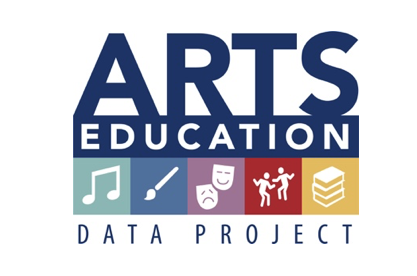Arts Education Data Project Accelerates from Partnerships with CMA Foundation and The Music Man Foundation
From Peter Giles, Giles Communications –
 The CMA Foundation, the philanthropic arm of the Country Music Association, and The Music Man Foundation have added their voices and financial resources to the Arts Education Data Project (www.artseddata.org) — an ambitious research campaign that’s revolutionizing the understanding of, and increasing participation in, arts education in the United States.
The CMA Foundation, the philanthropic arm of the Country Music Association, and The Music Man Foundation have added their voices and financial resources to the Arts Education Data Project (www.artseddata.org) — an ambitious research campaign that’s revolutionizing the understanding of, and increasing participation in, arts education in the United States.
A joint effort between State Education Agency Directors of Arts Education (SEADAE) and Quadrant Research, the project is a systemic, data-driven approach to charting the current status of arts education in the United States. By providing valuable insights about arts education’s future direction, the project ultimately serves to increase student participation in all schools across the country.
Grants from the CMA Foundation and The Music Man Foundation combine with support from other longtime partners including the William and Flora Hewlett Foundation, NAMM Foundation, Ohio Arts Council, and Little Kids Rock.
This new round of funding will help the AEDP scale nationally, so that states will, for the first time, be able to move the conversation about the status and condition of arts education from opinion to factual evidence, while empowering arts educators and supporters to better support their programs.
Led by longtime arts advocate and researcher Robert Morrison, Quadrant Research, in partnership with SEADAE, undertook the Arts Education Data Project to reveal the true status and condition of arts education in the more than 100,000 schools serving more than 50 million students across the country. This initiative is accomplished by taking data gathered by each state department of education, standardizing the data and then transforming it into a publicly available interactive dashboard, updated annually to reflect the true status of arts education in every school, at every grade level for every student.
Unlike programs where data is gathered for its own sake, the project uses the information as a launchpad for understanding how specific communities and demographic groups access arts instruction in schools. It’s fundamentally changing the way educators see their programs — and the way funds are reaching classrooms.
“Arts education, especially music, continues to be a driving factor in student success both at school and in their communities, helping to shape our next generation to be collaborative, forward-thinking leaders,” said Tiffany Kerns, executive director, CMA Foundation. “It is critical that arts education be included in the curriculum as we believe it is vital to a well-rounded education for students today and in the future. By investing in the Arts Education Data Project, we are able to gain insight and intel that can be utilized throughout the country to move the needle in access and equity for all students. Through this partnership, we will continue to evaluate promising practices across each state, and in different regions, to better create a model that can be implemented and tracked for success.”
“Too often, the children who need arts education the most have the fewest opportunities to access it. In California, the Arts Education Data Project illuminated this shortfall and we have marveled at how various partners have been able to triage the situation,” says Sarah Lyding, executive director, The Music Man Foundation. “As the Foundation aims to support programs that use music to improve children’s lives, we appreciate how the Data Project allows us to easily identify the schools and districts where our partners can fill a void. As the Project rolls out across the country, our hope is that stakeholders in every state will be empowered with data to make more equitable decisions for students.”
The program was first launched in Quadrant Research’s home state of New Jersey and quickly bore unprecedented results. For the first time, administrators were provided detailed objective data showing the status of arts education, diversity of course offerings and equity of program distribution.
“New Jersey used the data to tackle the imbalance between different districts and bring the arts to more communities,” Morrison says. “Participation in arts education has gone from 65 percent in 2006 to 81 percent in 2018. That means more than 250,000 students are taking part in school-based arts programs every year than a decade ago.”
Today, New Jersey is widely recognized as a national leader in arts education, and in 2019, it became the first state in the nation to provide universal access to arts education for all public-school students.
California was next to work with Quadrant Research and SEADAE, and the data they provided played a key role in new legislation allocating $40 million to school-based arts programs.
Steve Venz, the former Music Supervisor for the LA Unified School District who now serves as Chief Program Officer for Little Kids Rock, says that the data project is all about bringing transparency to arts education.
“Traditionally, we simply didn’t have access to student information systems, district to district,” recalls Venz. “When the Arts Education Data Project was rolled out in California, all of a sudden, things became very transparent, in terms of student enrollment in arts classes at the middle schools and high schools. Conversations around arts education shifted from opinions to looking at quantitative data. For example, it’s one thing to say that you ‘feel’ that kids are not getting access to arts education in middle school, and another to actually see it right in front of you.”
“Whether you’re a parent, teacher, arts administrator advocate, school board member or superintendent, the Arts Education Data Project enables anyone to gain access to the data immediately, to develop baselines and clearly see, year after year, where it is going,” adds Venz. “The result is that the state can now pull this information down quickly to develop federal grants and plans to further arts education. As this project goes nationwide, I believe it will eventually impact federal policy, enabling state-to-state comparisons to see what changes need to be made across the country.”
Echoing this sentiment is Todd Shipley, fine arts coordinator at the Tennessee Department of Education. “The most significant benefit derived from the Arts Education Data Project is that we finally have real quantitative data to backup decision making. This data helps us locate schools and districts where there is significant participation, to guide our placement of teachers in those areas. It also helps the philanthropic community in deciding where funds can best be applied.”
By the end of 2019, the project was informing decisions by educators in Arizona, California, Minnesota, New Jersey, New York, North Carolina, Ohio, Tennessee and Wisconsin, representing 33 percent of the student population in the country. Additional states in development are Arkansas, Connecticut, Florida, Iowa, Missouri, New Hampshire, Massachusetts, Pennsylvania, Oklahoma, and Texas, with several more states on tap to have their data unleashed as the new funding is secured.
Because the data provides detailed information within communities, it allows each state to build programs that suit its own students and teachers.
According to Morrison, the goal is to expand the project to 20 states in 2020 and to reach 98 percent of American students by the end of 2022.
“We want to bring the Arts Education Data Project to every state in the union,” says Morrison. “The funding from the CMA Foundation and The Music Man Foundation will make a huge difference in the lives of students. Educators are using our data to make better decisions about programs, and that makes for better outcomes for students. The ultimate goal here is for the data to be the catalyst to drive changes in arts education that will lead to increased participation for students across the nation.”
“Our collaborative efforts in this work not only provide the field with a more accurate picture of what is offered in arts education across the United States, but also serve to increase student arts participation in all schools across the country,” said Dr. Julie Palkowski, board member, SEADAE. “Having the support of our new partners in the CMA Foundation and The Music Man Foundation, along with our longtime partners, helps to elevate this work to include more states, as well as generate conversations about the importance of an arts education for all.”
About Quadrant Research
Quadrant Research is a nationally recognized leader in research, analysis, and market intelligence serving the fields of culture, commerce, government and education. Quadrant Research specializes in arts education and serves the four major arts disciplines: music, dance, theater and visual arts. Quadrant Research provides data, analysis, and market intelligence to give clients an accurate picture of current market conditions plus the knowledge needed for future growth.
About SEADAE
State Education Agency Directors of Arts Education (SEADAE) consists of those persons at state education agencies whose responsibility is education in the arts (Dance, Media Arts, Music, Theatre and Visual Arts). SEADAE’s mission is to support the professional effectiveness of individual members and provide a collective voice for leadership on issues affecting arts education. www.seadae.org
About the CMA Foundation
Established in 2011 as the philanthropic arm of the Country Music Association (CMA), the CMA Foundation is committed to improving and sustaining high-quality music education programs across the United States, working to ensure every child has the opportunity to participate in music. Through strategic partnerships, professional development and grant distribution, the CMA Foundation, a nonprofit 501(c)(3), has invested more than $27 million across the national public-school system, after school programs, summer camps and community outreach organizations. Guided by the generosity of the Country Music community, proceeds from CMA Fest, the four-day long music festival held annually in Nashville, are used to power the CMA Foundation’s social impact and unique model of giving. www.cmafoundation.org
About the Music Man Foundation
The Music Man Foundation is named after the Tony-winning musical written by Meredith Willson. Meredith’s widow, Rosemary, started the Foundation in 1998 as the Meredith and Rosemary Willson Charitable Foundation and substantially increased the Foundation’s endowment upon her death in 2010. With a mission to empower people using the transformative energy of music to make positive changes in their own lives and the lives of others, the Foundation currently focuses its investments in two initiative areas: core-curriculum music education and music therapy. Besides “The Music Man,” Meredith Willson wrote the musical, “The Unsinkable Molly Brown,” and beloved songs “It’s Beginning to Look a Lot Like Christmas” and the University of Iowa fight song.

